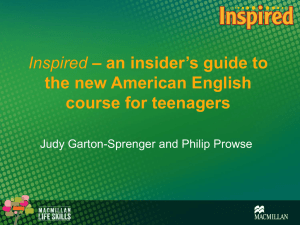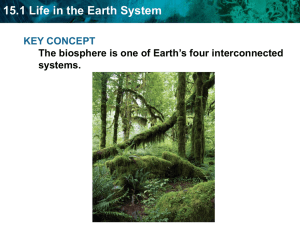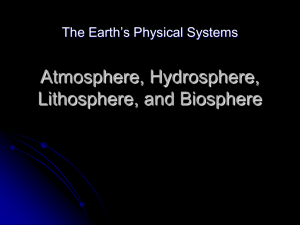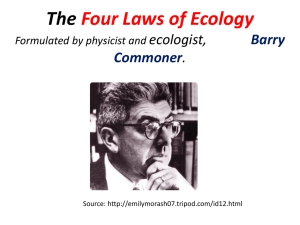Changemaking in Science Lesson Template
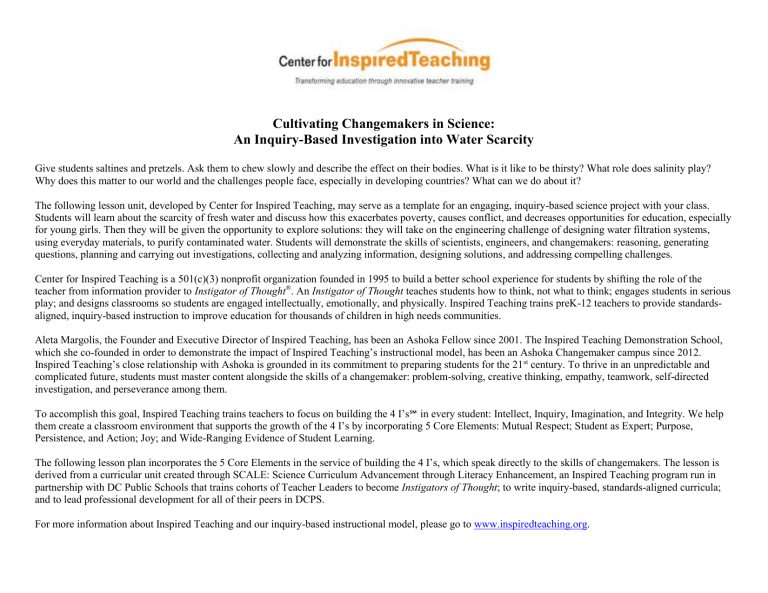
Cultivating Changemakers in Science:
An Inquiry-Based Investigation into Water Scarcity
Give students saltines and pretzels. Ask them to chew slowly and describe the effect on their bodies. What is it like to be thirsty? What role does salinity play?
Why does this matter to our world and the challenges people face, especially in developing countries? What can we do about it?
The following lesson unit, developed by Center for Inspired Teaching, may serve as a template for an engaging, inquiry-based science project with your class.
Students will learn about the scarcity of fresh water and discuss how this exacerbates poverty, causes conflict, and decreases opportunities for education, especially for young girls. Then they will be given the opportunity to explore solutions: they will take on the engineering challenge of designing water filtration systems, using everyday materials, to purify contaminated water. Students will demonstrate the skills of scientists, engineers, and changemakers: reasoning, generating questions, planning and carrying out investigations, collecting and analyzing information, designing solutions, and addressing compelling challenges.
Center for Inspired Teaching is a 501(c)(3) nonprofit organization founded in 1995 to build a better school experience for students by shifting the role of the teacher from information provider to Instigator of Thought
®
. An Instigator of Thought teaches students how to think, not what to think; engages students in serious play; and designs classrooms so students are engaged intellectually, emotionally, and physically. Inspired Teaching trains preK-12 teachers to provide standardsaligned, inquiry-based instruction to improve education for thousands of children in high needs communities.
Aleta Margolis, the Founder and Executive Director of Inspired Teaching, has been an Ashoka Fellow since 2001. The Inspired Teaching Demonstration School, which she co-founded in order to demonstrate the impact of Inspired Teaching’s instructional model, has been an Ashoka Changemaker campus since 2012.
Inspired Teaching’s close relationship with Ashoka is grounded in its commitment to preparing students for the 21 st century. To thrive in an unpredictable and complicated future, students must master content alongside the skills of a changemaker: problem-solving, creative thinking, empathy, teamwork, self-directed investigation, and perseverance among them.
To accomplish this goal, Inspired Teaching trains teachers to focus on building the 4 I’s ℠ in every student: Intellect, Inquiry, Imagination, and Integrity. We help them create a classroom environment that supports the growth of the 4 I’s by incorporating 5 Core Elements: Mutual Respect; Student as Expert; Purpose,
Persistence, and Action; Joy; and Wide-Ranging Evidence of Student Learning.
The following lesson plan incorporates the 5 Core Elements in the service of building the 4 I’s, which speak directly to the skills of changemakers. The lesson is derived from a curricular unit created through SCALE: Science Curriculum Advancement through Literacy Enhancement, an Inspired Teaching program run in partnership with DC Public Schools that trains cohorts of Teacher Leaders to become Instigators of Thought ; to write inquiry-based, standards-aligned curricula; and to lead professional development for all of their peers in DCPS.
For more information about Inspired Teaching and our inquiry-based instructional model, please go to www.inspiredteaching.org
.
Water Water Everywhere and Not a Drop to Drink!
Grade:
6 th Grade Earth Science
Developed by: Nicole McGill
Topic:
Water Scarcity & Designing Water Filtration Systems
Timing (Based upon 45 min/day)
Engage: 1 day
Explore: 1 day
Explain: 2 days
Elaborate: 2 days
Evaluate: 1 day
Total: 7 days
Brief Description:
In this inquiry and engineering design project, students explore water scarcity, water pollution, and methods of water filtration.
NGSS Performance Expectation(s):
Performance Expectation MS-ESS3-1
Construct a scientific explanation based on evidence for how the uneven distributions of Earth's mineral, energy, and groundwater resources are the result of past and
current geoscience processes.
[Clarification Statement: Emphasis is on how these resources are limited and typically non-renewable, and how their distributions are significantly changing as a result of removal by humans. Examples of uneven distributions of resources as a result of past processes include but are not limited to petroleum (locations of the burial of organic marine sediments and subsequent geologic traps), metal ores (locations of past volcanic and hydrothermal activity associated with subduction zones), and soil
(locations of active weathering and/or deposition of rock).]
Performance Expectation MS-ESS3-3
Apply scientific principles to design a method for monitoring and minimizing a human impact on the environment.
Clarification Statement: Examples of the design process include examining human environmental impacts, assessing the kinds of solutions that are feasible, and designing and evaluating solutions that could reduce that impact. Examples of human impacts can include water usage (such as the withdrawal of water from streams and aquifers or the construction of dams and levees), land usage (such as urban development, agriculture, or the removal of wetlands), and pollution (such as of the air, water, or land).]
Performance Expectation MS-ESS3-4
Construct an argument supported by evidence for how increases in human population and per-capita consumption of natural resources impact Earth’s systems.
Clarification Statement: Examples of evidence include grade-appropriate databases on human populations and the rates of consumption of food and natural
© 2015 Center for Inspired Teaching 2
resources (such as freshwater, mineral, and energy). Examples of impacts can include changes to the appearance, composition, and structure of Earth’s systems as well as the rates at which they change. The consequences of increases in human populations and consumption of natural resources are described by science, but science does not make the decisions for the actions society takes.]
Specific Learning Outcomes:
Evidence of Learning Specifications
Construct an argument supported and based on evidence of how the uneven distribution of Earth’s waters cause problems related to accessing clean water
1.
Describe issues related to accessing clean water
2.
Design a solution to clean water
3.
Explain causes and effect relationships involved in water contamination
Design a tool, object, process or system to purify water
1.
Define a problem with water
2.
Describe the cause and effect of water contamination
3.
Apply scientific principles
4.
Explain how structure of design minimizes the water contamination
© 2015 Center for Inspired Teaching 3
NGSS Standards
Prior Student Knowledge:
ESS2-C: The Roles of Water in Earth’s Surface Processes
● Water continually cycles among land, ocean, & atmosphere vis transpiration, evaporation, condensation and crystallization, and precipitation, as well as downhill flows on land.
● The complex patterns of the changes and the movement of water in the atmosphere, determined by winds, landforms, and ocean temperatures and currents, are major determinants of local weather patterns
Science and Engineering Practices:
Asking Questions & Defining Problems
Define and design problem that can be solved through the development of an object, tool, process or system and includes multiple criteria and constraints, including scientific knowledge that may limit possible solutions.
Obtaining, Evaluating & Communicating
Information
Gather, read and synthesize information from multiple appropriate sources and assess the credibility, accuracy, and possible bias of each population and methods used, and describe how they are supported or not supported by
Disciplinary Core Ideas:
NATURAL RESOURCES
Humans depend on Earth’s land, ocean, atmosphere, and biosphere for many different resources. Minerals, fresh water, and biosphere resources are limited, and many are not renewable or replaceable over human lifetimes. These resources are distributed unevenly around the planet as a result of past geologic processes.
HUMAN IMPACT on EARTH’S SYSTEMS
Human activities have significantly altered the biosphere, sometimes damaging or destroying natural habitats and causing the extinction of others species. But changes to Earth’s
Crosscutting Concepts:
Structure and Function and used.
Cause and Effect
Structures can be designed to serve particular functions by taking into account properties of different materials, and how materials can be shaped
Cause and effect relationships may be used to predict phenomena in natural or designed systems. evidence
Constructing Explanations & Designing
Solutions
Construct a scientific explanation based on environments can have different impacts
(negative & positive) for different living things.
© 2015 Center for Inspired Teaching 4
valid and reliable evidence obtained from sources (including the students’ own experiments) and the assumption that theories & laws that describe the natural world operate today as they did in the past and will continue to do so in the future.
Apply scientific principles to design an object, tool, process or system
Possible Preconceptions/Misconceptions:
● That there is plenty of water because the planet contains so much. Could clarify this with respect to how much of the water is suitable for drinking.
● Earth has 3% fresh water and 97% of salt water
● Students may hold the misconception that our water supply is “running out” or being “used up”, rather than it is becoming polluted
● and unusable.
The biggest false assumption is that potable water has low cost or is free. The public expects clean and accessible water, at all times, takes for granted that water is being harvested, cleaned, filtered, pressurized, distributed, and delivered, without paying for the real cost. (This could be addressed by looking at cost of maintaining wastewater treatment facilities.
© 2015 Center for Inspired Teaching 5
Lesson Plan- 5E Model
5E Model
Stages
Engage
Lesson Description
(includes NGSS Science & Engineering Practices)
NGSS Disciplinary Core Ideas NGSS Crosscutting Concepts
Objective: By the end of this lesson, students will be able to describe water as a limited resource in order to define problems in accessing fresh water as a natural resource.
Understanding limitations
Group students in 4s.
Round 1: Pass a ball around using your hands. Make sure that each member of your team touches the ball with both hands. Do not drop the ball. If the ball drops, you must start over.
Round 2: Pass the ball without using your hands. You may use anybody parts but not your hands. Do not drop the ball; you may be as creative in passing the ball. If the ball drops you must start over.
Ask:
● What did it feel like when the resources you needed (your hands) to complete your task (passing the ball) were limited or unavailable?
Show Video clip of the importance of water https://www.youtube.com/watch?v=-eNPizFUhBU (“Water: An
Absent Necessity” Long Walk to water type video; shows connection between lack of water and poverty; 6:00)
Ask:
● What does it feel like to be thirsty?
Human Impact on Earth’s Systems
Human activities have significantly altered the biosphere, sometimes damaging or destroying natural habitats and causing the extinction of others species. But changes to
Earth’s environments can have different impacts (negative & positive) for different living things.
Natural Resources
Humans depend on Earth’s land, ocean, atmosphere, and biosphere for many different resources.
Minerals, fresh water, and biosphere resources are limited, and many are not renewable or replaceable over human lifetimes.
These resources are distributed unevenly around the planet as a result of past geologic processes.
The Role of Water in Earth’s Surface
Processes
Water continually cycles among land, ocean, & atmosphere via transpiration, evaporation,
Cause and Effect
Cause and effect relationships may be used to predict phenomena in natural or designed systems.
© 2015 Center for Inspired Teaching 6
Provide each group with crackers and pretzels.
Say: Take your time eating each cracker/pretzel. Please eat one at a time.
Ask probing questions:
● What does salt do?
● What are the short term and long term effects of salt on your body?
● How does your mouth feel after eating the salty snack with nothing to wash it down?
● What’s bad about salt?
● What are some other times they’ve felt really, really thirsty?
Record student responses on chart paper
Remind students to eat the saltines one at a time.
Say: On Earth what do we have more of salt water or fresh water?
Ask:
● Which is more beneficial to drink?
● Based on your experience of eating saltines and the video clip, let’s brainstorm on how it may feel to be thirsty all the time.
Jot your thoughts on paper/journal)
Narrative Writing
Ask/Write probing questions:
● What are some situations where someone might really be thirsty?
● If this where a story of the thirstiest person, where would this story take place? condensation & crystallization, & precipitation as well as downhill flows on land.
The complex patterns of changes and the movement of water in the atmosphere, determined by winds, landforms, and ocean temperatures and currents, are major determinants of local weather patterns
© 2015 Center for Inspired Teaching 7
● Who are the characters?
● How does the main character become so, so thirsty?
● How does the character feel when he or she gets really thirsty? Think back to your own experience with the salty snacks to describe the character’s thoughts or senses.
Students write Part 1 of The Thirstiest Person in the World: “I’m so thirsty” focusing on setting & exposition for the story
© 2015 Center for Inspired Teaching 8
Explore
Objective: By the end of this lesson, students will be able to demonstrate how to test acids and bases in order to design a pH
spectrum.
Recap on salt water:
What is bad about salt?
What would happen if we only drank salt water?
Push Inquiry question:
We put salt on our food, right?
Anticipated student response:
Salt water will suck a lot of water out of your body.
Present dehydrated fruit(s) or vegetable(s) to show what salt water can do.
Ask:
● What do you think acids and bases are?
● Have you eaten anything sour?
● What are some examples of acids or bases
Try to not give examples in order to promote open inquiry and have students come up with examples on their own.
Write responses on Chart paper
Teacher provide parameters of the investigation:
Parameters of the investigation
● Avoid horseplay when handling materials during hands-on activity to prevent serious injury
● Read carefully all procedures
The Role of Water in Earth’s Surface
Processes
Water continually cycles among land, ocean, & atmosphere via transpiration, evaporation, condensation & crystallization, & precipitation as well as downhill flows on land.
The complex patterns of changes and the movement of water in the atmosphere, determined by winds, landforms, and ocean temperatures and currents, are major determinants of local weather patterns
Natural Resources
Humans depend on Earth’s land, ocean, atmosphere, and biosphere for many different resources.
Minerals, fresh water, and biosphere resources are limited, and many are not renewable or replaceable over human lifetimes.
These resources are distributed unevenly around the planet as a result of past geologic processes.
Cause and Effect
Cause and effect relationships may be used to predict phenomena in natural or designed systems.
Systems & System Models
Models can be used to represent systems and their interactions—such as inputs, processes and outputs—and energy, matter, and information flows within systems.
© 2015 Center for Inspired Teaching 9
● Be sure that any modifications made to the activity are properly noted
● Record all observations in the designated place
● Adhere to all lab safety procedures provided by the teacher in advance
Encourage students to work together without direct instruction.
Provide students with time to puzzle.
Students complete Cabbage Rainbow pHun investigation: http://web.stanford.edu/~ajspakow/downloads/outreach/phstudent-9-30-09.pdf
Round 1: Students test pH of Individual ingredients using Red cabbage indicator (vinegar, baking soda, salt)
Round 2: Students test mixture of 2 ingredients (any 2)
Round 3: Students test Super Solution (mix all 3)
Ask:
● What connections can you make between our pH activity and the health of our drinking water?
Alternative activity
Simulation: https://phet.colorado.edu/en/simulation/ph-scale-basics
When investigation is complete use your prepped pH scale to demonstrate/model how pH strips work on household beverages
Ask:
How do acids and bases play a role in water testing? Do you think tap water is tested? Explain your thoughts.
© 2015 Center for Inspired Teaching 10
Explain
Objective: By the end of this lesson, students will be able to explain the cause and effects of water contamination in order to
analyze contaminated water.
Ask:
What does contamination mean?
Encourage students to explain in their own words.
Provide Literature http://www.readworks.org/passages/water-woes
Ask:
Based on your reading…
● What do you think are signs of good and bad water?
Anticipated student responses: water smells, looks murky, taste
funny, looks dirty, has things floating in it, smells bad
● What is your definition of contamination?
● What do you think acids and bases are used for when testing water?
● Should water have acid in it?
● How would we know if it were any acids in the water?
● What are some things that you think are in water that make the acidity high?
Provides literature on the water contamination
Printouts of CDC info on waterborne diseases and contaminants
(see links below www.cdc.gov/healthywater/drinking/public/water_diseases.html
www.cdc.gov/healthywater/drinking/private/wells/diseases.html
Students refine their definition for contamination
Human Impact on Earth’s Systems
Human activities have significantly altered the biosphere, sometimes damaging or destroying natural habitats and causing the extinction of others species. But changes to
Earth’s environments can have different impacts (negative & positive) for different living things.
Cause & Effect
Relationships can be classified as causal or correlational, and correlation does not necessarily imply causation.
© 2015 Center for Inspired Teaching 11
Narrative writing
Students add Part 2 to their original story of The Thirstiest Person in the World: “Are you going to drink that?” where he or she finds water that may or may not be safe to drink.
© 2015 Center for Inspired Teaching 12
Elaborate
Objective: By the end of this sequence, students will be able to create a water filtration system in order to demonstrate how contaminated water can be purified.
Ask:
How do you remove pasta from water?
How do you remove pulp from juice?
Show video:
Link to video: https://www.youtube.com/watch?v=BCHhwxvQqxg
(“Water Changes Everything” Another long walk to water, showing the effect of time spent gathering water; talks about the contaminants in water that can lead to death; introduces the solution of safe water projects that clean water through filtration systems on a small scale; 3:24)
In advance, teacher prepares water contaminated with baking soda, vinegar, salt, potting soil, sand, etc.
Students engineer water filtration system
Potential filter materials- soil, sand, cotton balls, pebbles or rocks & charcoal chunks
1. Cut 2-liter plastic bottle crosswise
2. Turn the top upside down, then add the cheesecloth
3. Add the filter material (i.e. rocks/pebbles, cotton balls, charcoal chunks, soil, sand (Students may place materials in however they choose. They will have a chance to revise their procedures and materials when they test again. Students should do at least 3
rounds.)
4. Set your filter on top of the bottom half
5. Pour in liquid
6. Collect cleaner water
Human Impact on Earth’s Systems
Human activities have significantly altered the biosphere, sometimes damaging or destroying natural habitats and causing the extinction of other species. But changes to
Earth’s environments can have different impacts (negative and positive) for different living things.
Natural Resources
Humans depend on Earth’s land, ocean, atmosphere, and biosphere for many different resources.
Minerals, fresh water, and biosphere resources are limited, and many are not renewable or replaceable over human lifetimes.
These resources are distributed unevenly around the planet as a result of past geologic processes.
Systems & System Models
Models can be used to represent systems and their interactions—such as inputs, processes and outputs—and energy, matter, and information flows within systems.
Stability and Change
Stability might be disturbed either by sudden events or gradual changes that accumulate
© 2015 Center for Inspired Teaching 13
7. Draw reasonable conclusions about effectiveness of filter using evidence
8. Using information to redesign filter
Students should also test water for pH before and after filtration using cabbage juice indicator
Probing Questions (after filtration activity)
Ask:
What did you think the ideal filter will be?
What were your findings?
What do you know now?
What do you think would happen if you added/took away one of the elements from your design?
Make sure students use formal labels, definitions, and explanations.
Extension: What are some benefits and drawbacks of different water purification systems?
Article Suggestions: http://www.water-treatment.org.uk/water_treatment.html
Narrative writing
Students continue their story with Part 3: “A bitter end?” where he or she must face the challenge of trying to purify the potentially contaminated water.
(Extension opportunity: Field trip to local water purification plant)
© 2015 Center for Inspired Teaching 14
Evaluate
Objective: By the end of the sequence, students will be able to design a system to purify water in order to construct an argument
on how to access clean water.
Ask:
What do you know about purification of water?
What kinds of filters were effective at purifying acids and bases, or removing gunk from water?
What worked and what didn’t?
If we stacked all of the filters on top of each other what would be the benefit of that? Would the water be cleaner?
Students write an analysis of their filtration system which includes:
● A scientific definition of water contamination
● An explanation of the causes and effects of water contamination
● An explain of how the structure of their design reduces water contamination
Narrative writing
Students conclude their story with Part 4: “A better end” where he or she ultimately finds a way to filter the water and relieve his/her thirst.
Students create a PSA Poster including images that summarize their
“Thirstiest Person in the World” narrative writing, and which support the protection and responsible use of natural resources.
1. I’m so Thirsty
2. Are you going to drink that?
3. A Bitter End
4. A Better End
Human Impact on Earth’s Systems
Human activities have significantly altered the biosphere, sometimes damaging or destroying natural habitats and causing the extinction of other species. But changes to
Earth’s environments can have different impacts (negative and positive) for different living things.
Natural Resources
Humans depend on Earth’s land, ocean, atmosphere, and biosphere for many different resources.
Minerals, fresh water, and biosphere resources are limited, and many are not renewable or replaceable over human lifetimes.
These resources are distributed unevenly around the planet as a result of past geologic processes.
Structure & Function
Structures can be designed to serve particular functions by taking into account properties of different materials, and how materials can be shaped and used.
Cause & Effect
Cause and effect relationships may be used to predict phenomena in natural or designed systems.
© 2015 Center for Inspired Teaching 15
Saltine crackers
Pretzels
pH strips
Sodas (3 different kinds)
Cheesecloth
Orange juice
2 liter empty Soda bottles
Clear plastic cups
Salt
Baking Soda
Vinegar
Materials Required for This Instructional Sequence
Brita pitcher (or other water-filtration
pitcher)
Basketball or other similarly sized ball
Quantity
1
●
1 for every ● Blender (to make cabbage juice
4 students
● Red cabbage leaves (to make
cabbage juice indicator)
indicator)
1/student ● Strainer
1/student ● 250-mL beaker or clear container
~5/student ● Medicine droppers (1 per test group substance)
1 of each ● Sheet of white paper
1 sq. foot/ ● 50-mL beakers or clear containers, (1 student group
per test substance)
1 container ● Ammonia (household)
1/ student Dehydrated fruit: apples, raisins, group bananas, apricots, etc.
(2 per student)
●
Potting soil
1 shaker Tap Water
1 box ● Rocks/aquarium gravel
1 bottle
● Charcoal chunks
Quantity
1 head
1
1
1 variable
1 variable
1 jug
1 bag of each
1 bag
1 bag
1/student group
© 2015 Center for Inspired Teaching 16


